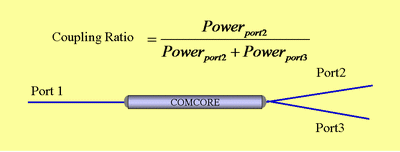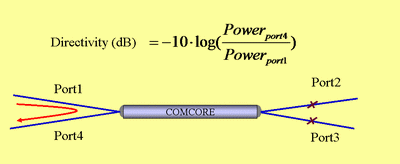Terminologies
A
Attenuator - A passive optical component that intentionally reduces the optical power propagating in a fiber.
Allwavelength - the components can work covering all wavelengths from 1270nm to 1610nm.
B
Bandwidth - A range of wavelengths over which a component will meet specifications.
C
Coupler(s) - Any optical structures, which could realize any percentage of optical power coupling from one port to any other ports or from one fiber to any other neighbor fibers, it will include longitude coupling and transversal coupling.
Center Wavelength(s) - The nominal operating wavelength(s).
Cladding - The outer concentric layer that surrounds the fiber core and has a lower index of refraction.
Core - The central, light carrying part of an optical fiber; it has an index of refraction higher than that of the surrounding cladding.
D
dB(Decibel) - Unit of measurement of signal strength.
Decibel - A standard logarithmic unit for the ratio of two powers, voltages, or currents. In fiber optics, the ratio is power.
Dispersion - A general term for those phenomena that cause a broadening or spreading of light as it propagates through an optical fiber. The three types are modal, material, and waveguide.
E
EDFA - Erbium-doped fiber amplifier.
Erbium-doped fiber amplifier - A type of fiber that amplifies 1550-nm optical signals when pumped with a 980- or 1480-nm light source.
Excess Loss - The ratio of the total output power of a passive component with respect to the input power.
F
Fused Fiber Products or Components - A method of making any optical fiber components by using heating or fusing or melting process.
I
Index of Refraction - The ratio of the velocity of light in free space to the velocity of light in a given material. Symbolized by N.
Insertion Loss(IL) - Attenuation expressed in dB for a particular path through a component. Normally, insertion loss includes excess loss, splitting loss and polarization effects.
Isolation - Also referred to as far-end cross-talk or far-end isolation. Predominantly used in reference to WDM products, it is a measure of light at an undesired wavelength relative to the desired wavelength.
L
Loss - Optical power reduction resulting from any optical assembling or process.
Loss-Free Devices - which has extremely low excess near to Zero dB.
M
Multimode Fibers - which can sustain more than one mode propagation in the optical fiber for specified operating wavelength. Normally, we have several industrialization fibers such as 50/125μm fiber, 62.5/125μm fiber, 105/125μm fiber, 100/140μm fiber, and some of large-core multimode fiber.
Mixer - any optical power distributors with more than 1 input port and at least one output port.
P
Pigtail - A short length of fiber permanently attached to a component, such as a source, detector, or coupler.
Polarization Sensitivity - The variation in insertion loss as the polarization state of the input light is varied.
PM fibers - all of fiber, which have the capability of maintaining the state polarized light from the input port to the output port.
PM Splitter - the splitter are made using PM fiber, it can split one polarized path becoming two or more paths.
R
Return Loss - Also called back reflection; is light that is reflected back along the path of transmission, from either the coupling region, the connector or a terminated fiber.
Return Reflection - Reflected optical energy that propagates backward to the source in an optical fiber.
S
Single-mode fiber - An optical fiber that supports only one mode of light propagation above the cutoff wavelength.
Splitter - A passive device that distributes optical power among two or more ports. (Can be in various ratios.) Commonly called a splitter.
Star Mixer - An all-fiber-optic coupler in which power at any input port is distributed to all output ports.
T
Tap Loss - In a fiber optic splitter, the ratio of power at the tap port to the power at the input port.
Tap-Port - A coupler in which the splitting ratio between output ports is not equal, the output port containing the lesser power.
TDM - Time-division multiplexing
Temperature Stability - A measure of insertion loss variation as the device undergoes changes in temperature.
U
Uniformity - The maximum insertion loss difference between output ports of a splitter within operating bandwidth.
W
Wavelength - The distance between the same two points on adjacent waves; the time required for a wave to complete a single cycle.
Wavelength Dependence(Insertion loss flatness) - The variation in an optical parameter caused by a change in the operating wavelength.
Wavelength-Division Multiplexing - A transition technique by which separate optical channels, distinguished by wavelength, are multiplexed onto an optical fiber for transmission.
WDM - Wavelength-division multiplexing.

Coupling Ratio - The percentage of light transferred to a receiving output port with respect to the total power of all output ports.

Directivity - Also referred to as near-end crosstalk, it is the amount of power observed at a given input port with respect to an initial input power.

Demultiplexer - The process of separating optical channels.

Multiplexer - The process of combining optical channels.
|







